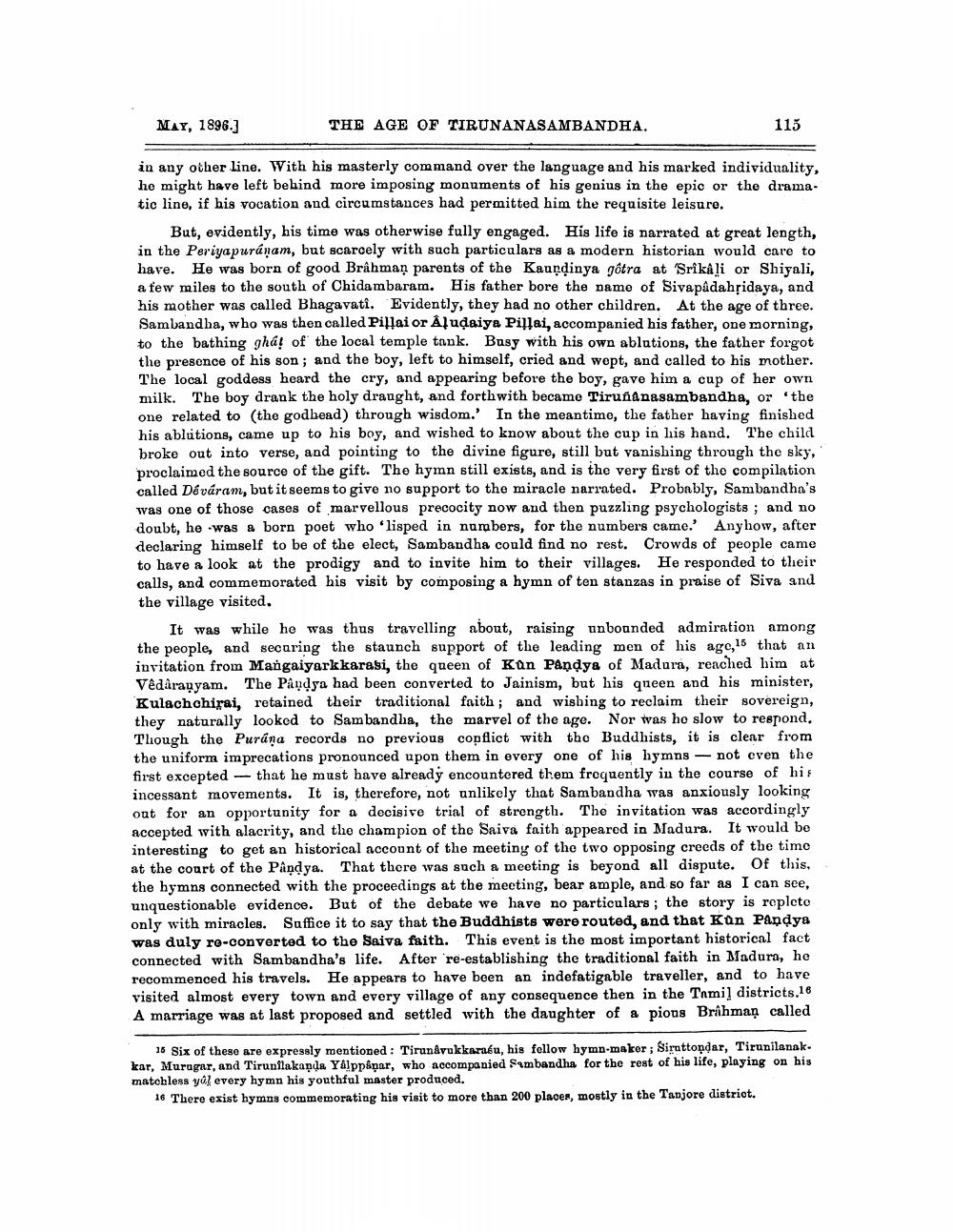________________
MAY, 1896.)
THE AGE OF TIRUNANASAMBANDHA.
115
in any other line. With his masterly command over the language and his marked individuality, he might have left behind more imposing monuments of his genius in the epic or the dramatic line, if his vocation and circumstances had permitted him the requisite leisure.
But, evidently, his time was otherwise fully engaged. His life is narrated at great length, in the Periyapuránam, but scarcely with such particulars as a modern historian would care to have. He was born of good Brahman parents of the Kausdinya gôtra at Srikali or Shiyali, a few miles to the south of Chidambaram. His father bore the name of Sivapadahșidaya, and his mother was called Bhagavati. Evidently, they had no other children. At the age of three. Sambandha, who was then called Pillai or Aludaiya Pillai, accompanied his father, one morning, to the bathing gha! of the local temple tank. Busy with his own ablutions, the father forgot the presence of his son; and the boy, left to himself, cried and wopt, and called to his mother. The local goddess heard the cry, and appearing before the boy, gave him a cup of her own milk. The boy drank the holy draught, and forthwith becamo Tirunanasambandha, or the one related to the godbead) through wisdom.' In the meantime, the father having finished his ablutions, came up to his boy, and wished to know about the cup in his hand. The child broke out into verse, and pointing to the divine figure, still but vanishing through the sky, proclaimed the source of the gift. The hymn still exists, and is the very first of the compilation called Déváram, but it seems to give no support to the miracle narrated. Probably, Sambandha's was one of those cases of marvellous precocity now and then puzzling psychologists; and no doubt, he was a born poet who 'lisped in numbers, for the numbers came. Anyhow, after declaring himself to be of the elect, Sambandha could find no rest. Crowds of people came to have a look at the prodigy and to invite him to their villages. He responded to their calls, and commemorated his visit by composing a hymn of ten stanzas in praise of Siva and the village visited.
It was while he was thus travelling about, raising unbounded admiration among the people, and securing the staunch support of the leading men of his agc, 15 that an invitation from Mangaiyarkkarasi, the queen of Kun Pandya of Madura, reached him at Vedårayyam. The Pandya had been converted to Jainism, but his queen and his minister, Kulachchirai, retained their traditional faith ; and wishing to reclaim their sovereign, they naturally looked to Sambandha, the marvel of the age. Nor was he slow to respond. Though the Purana records no previous copflict with the Buddhists, it is clear from the uniform imprecations pronounced upon them in every one of his hymns - not even the first excepted - that he must have already encountered them frequently in the course of his incessant movements. It is, therefore, not unlikely that Sambandha was anxiously looking out for an opportunity for a decisive trial of strength. The invitation was accordingly accepted with alacrity, and the champion of the Saiva faith appeared in Madura. It would be interesting to get an historical account of the meeting of the two opposing creeds of the timo at the court of the Pandya. That there was such a meeting is beyond all dispute. Of this, the hymns connected with the proceedings at the meeting, bear ample, and so far as I can see, unquestionable evidence. But of the debate we have no particulars; the story is repleto only with miracles. Suffice it to say that the Buddhists were routed, and that Kun Pandya was duly re-converted to the Saiva faith. This event is the most important historical fact connected with Sambandha's life. After re-establishing the traditional faith in Madura, he recommenced his travels. He appears to have been an indefatigable traveller, and to have visited almost every town and every village of any consequence then in the Tamil districts.16 A marriage was at last proposed and settled with the daughter of a pious Brahman called
15 Six of these are expressly mentioned : Tiranavukkarabu, his fellow hymn-maker; Biruttoņdar, Tirunilanak. kar, Murugar, and Tirunilakapda YAppapar, who accompanied Sambandha for the rest of his life, playing on his matchless yůl every hymn his youthful master produced.
16 There exist hymns commemorating his visit to more than 200 places, mostly in the Tanjore district.




